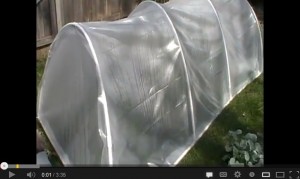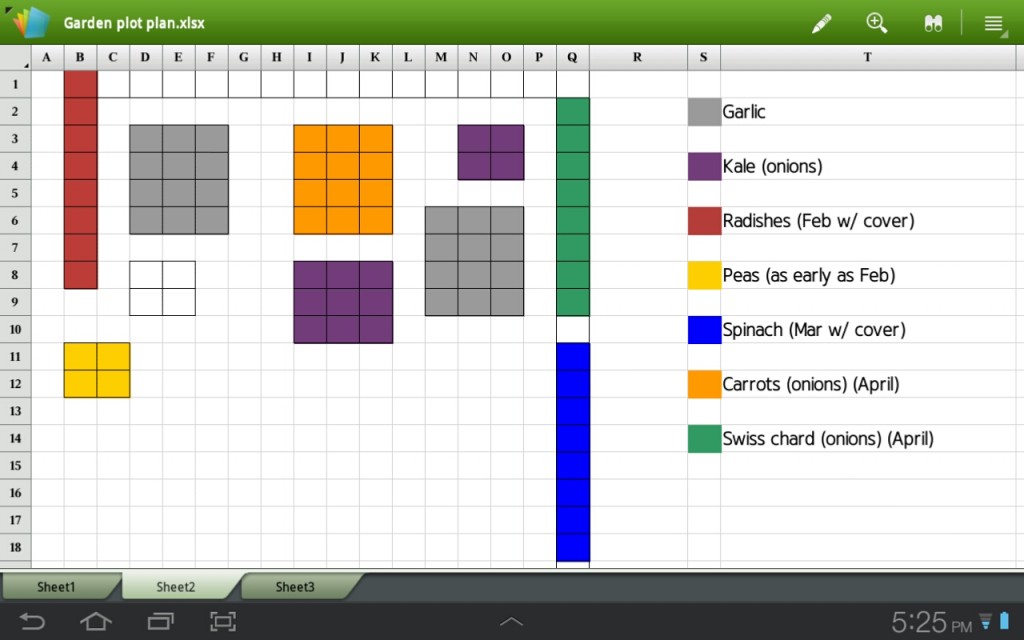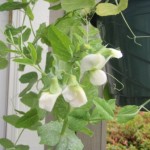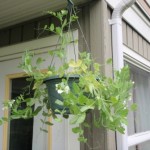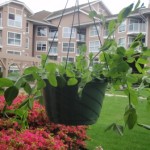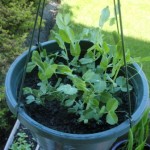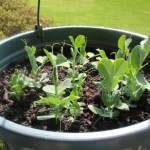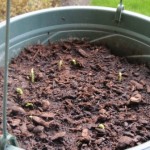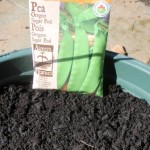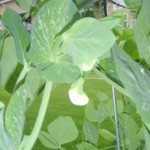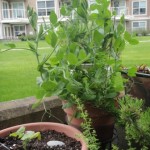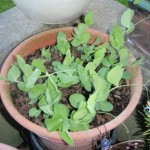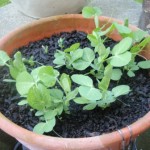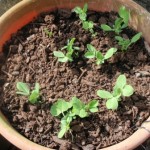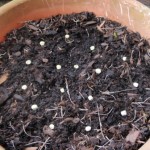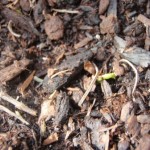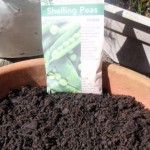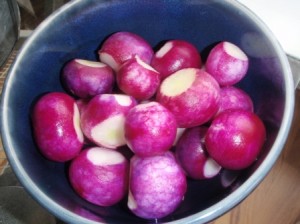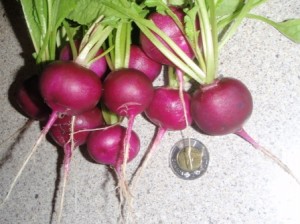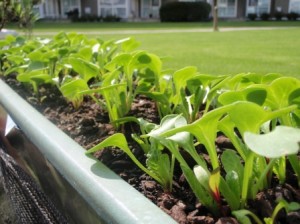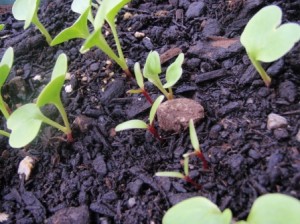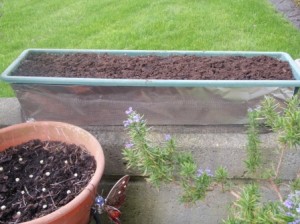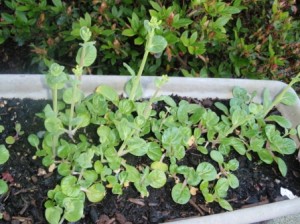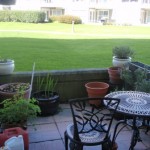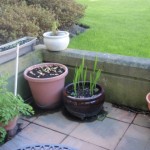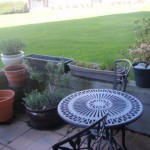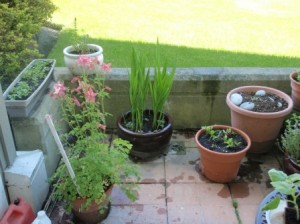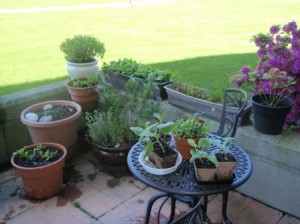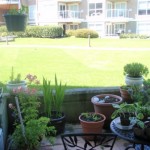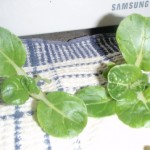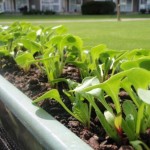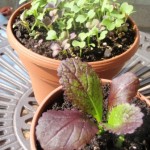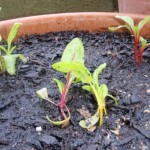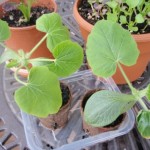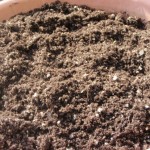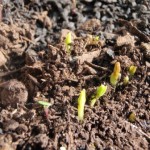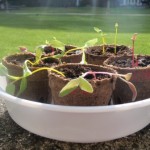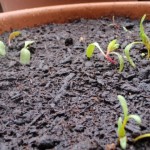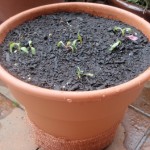I’ve been pretty busy this week and didn’t get to post as much as usual, but I did take some photos. Temperatures have warmed up to consistently above 10 degrees Celsius and have had some very sunny days, as well as some very rainy days! Ah springtime in Vancouver! But we also had several days where the wind was blowing in from the west and there was a salty sea air that is so refreshing! That’s one of my favourite things about living on the coast!
It’s about 5 1/2 weeks into Spring and since I started working on my outdoor vegetable garden. I have seedlings galore and can’t wait to start harvesting!
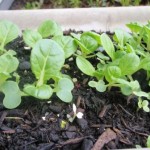 Toy Choy – At 5 1/2 weeks, my baby bok choy is about 2 inches tall. I’ll wait until they get a little bigger before I harvest them, as I really like them in stir fry! I initially spread seeds all over the container, then 2 weeks later added more to the right-hand side of the planter, then 2 weeks after that I reseeded the left-hand side. Next year, I will seed one side, then seed the other, and alternate… that makes more sense.
Toy Choy – At 5 1/2 weeks, my baby bok choy is about 2 inches tall. I’ll wait until they get a little bigger before I harvest them, as I really like them in stir fry! I initially spread seeds all over the container, then 2 weeks later added more to the right-hand side of the planter, then 2 weeks after that I reseeded the left-hand side. Next year, I will seed one side, then seed the other, and alternate… that makes more sense.
Buckwheat – At 5 1/2 weeks the buckwheat seems to be suffering. We’ve had a pretty cold spring and quite a bit of rain, so I think that’s why the buckwheat is still so small and yellow. It does tell me that I need to add some more sand to the container to improve drainage, though, before I plant my squash in the same soil. However, I have a rogue mesclun lettuce seed that grew from last year (the purply plant). This is what the mesclun in my small patio table container will eventually look like.
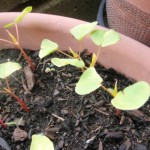

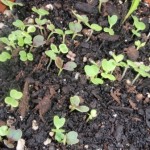 Mesclun – About 11 days after planting the mesclun seed mix, I have a lot of tiny seedlings. They benefited from being covered for two days under a plastic produce bag to create a greenhouse effect. The planter was uncovered for several days after sowing with no movement, then I covered it over and within a day they sprouted. Just providing the extra few degrees of warmth really seems to make a difference. I will have to thin these out soon, but when they are a little bigger.
Mesclun – About 11 days after planting the mesclun seed mix, I have a lot of tiny seedlings. They benefited from being covered for two days under a plastic produce bag to create a greenhouse effect. The planter was uncovered for several days after sowing with no movement, then I covered it over and within a day they sprouted. Just providing the extra few degrees of warmth really seems to make a difference. I will have to thin these out soon, but when they are a little bigger.
 Peas – Both the Little Marvel and Oregon Sugar Pod are doing well after their second sowing. The Oregon Sugar Pod seems to have done well even with the cool Spring, though it is placed much closer to the building and likely got more ambient warmth to help with germination. The Little Marvel has been less successful and I think I may need to re-sow a third time to fill in some gaps. However, that planter was further from the building and was exposed to more cold, wind
Peas – Both the Little Marvel and Oregon Sugar Pod are doing well after their second sowing. The Oregon Sugar Pod seems to have done well even with the cool Spring, though it is placed much closer to the building and likely got more ambient warmth to help with germination. The Little Marvel has been less successful and I think I may need to re-sow a third time to fill in some gaps. However, that planter was further from the building and was exposed to more cold, wind 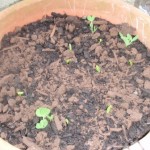 and rain. It’s very possible that, even though I didn’t soak the seeds prior to sowing, they could have gotten water-logged with all the rain we’ve had. I also didn’t plant them very deep, so that could have also exposed the seedlings a bit too early. In any case, the Little Marvel seems to be doing better and I still think they’ll flourish soon.
and rain. It’s very possible that, even though I didn’t soak the seeds prior to sowing, they could have gotten water-logged with all the rain we’ve had. I also didn’t plant them very deep, so that could have also exposed the seedlings a bit too early. In any case, the Little Marvel seems to be doing better and I still think they’ll flourish soon.
 Swiss chard – About 6 days after I transplanted the Swiss chard outside, I seem to have had a planter mis-hap… or more accurately, a planter misplacement. I inadvertently had placed the planter under the corner of the balcony above my patio. We had some heavy rainfalls this week and the rain gathered at the point right above my chard planter and continuously dripped on my poor fragile seedlings (and made a big splashy mess on the patio floor!). So I’ve moved the
Swiss chard – About 6 days after I transplanted the Swiss chard outside, I seem to have had a planter mis-hap… or more accurately, a planter misplacement. I inadvertently had placed the planter under the corner of the balcony above my patio. We had some heavy rainfalls this week and the rain gathered at the point right above my chard planter and continuously dripped on my poor fragile seedlings (and made a big splashy mess on the patio floor!). So I’ve moved the 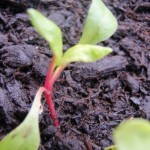 planter and planted some backup seeds in case my seedlings don’t make it. I also went over to a friend’s house (she is the one who gave me the chard seeds) and found that she has over 10 plants growing really well in a much shallower container! Even if all of my transplants survive and the new seeds sprout, I think I’m safe to keep them all!
planter and planted some backup seeds in case my seedlings don’t make it. I also went over to a friend’s house (she is the one who gave me the chard seeds) and found that she has over 10 plants growing really well in a much shallower container! Even if all of my transplants survive and the new seeds sprout, I think I’m safe to keep them all!
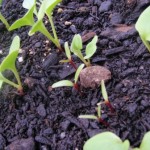 Beets & Radishes – The beets and radishes have also already sprouted and they’re not kidding that radishes grow fast! These seeds were sown about 14 days ago. The bigger seedlings with heart-shaped leaves are radishes, while the seedlings with the thin red stems are beets. They look similar to the Swiss chard seedlings because they are closely related.
Beets & Radishes – The beets and radishes have also already sprouted and they’re not kidding that radishes grow fast! These seeds were sown about 14 days ago. The bigger seedlings with heart-shaped leaves are radishes, while the seedlings with the thin red stems are beets. They look similar to the Swiss chard seedlings because they are closely related.
 Columbine – Aside from the Skimmia, the first of my flowers to bloom will be the columbine. It has had foliage most of the year, but it did die back in the winter. It has about 5 flowering stalks this year with multiple buds on each. Can’t wait for it to open!
Columbine – Aside from the Skimmia, the first of my flowers to bloom will be the columbine. It has had foliage most of the year, but it did die back in the winter. It has about 5 flowering stalks this year with multiple buds on each. Can’t wait for it to open!

